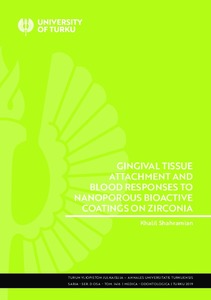Gingival tissue attachment and blood responses to nanoporous bioactive coatings on zirconia
Shahramian, Khalil (2019-04-14)
Gingival tissue attachment and blood responses to nanoporous bioactive coatings on zirconia
Shahramian, Khalil
(14.04.2019)
Turun yliopisto
Julkaisun pysyvä osoite on:
https://urn.fi/URN:ISBN:978-951-29-7597-6
https://urn.fi/URN:ISBN:978-951-29-7597-6
Kuvaus
ei tietoa saavutettavuudesta
Tiivistelmä
Zirconia implant abutments have gained popularity over the past few years as a substitute for the traditionally used titanium alloy abutments. However, research on the soft-tissue responses of zirconia and improving the zirconia surface properties towards immediate soft-tissue integration are limited.
This series of in vitro studies aimed at evaluating tissue and cellular responses of commercially available zirconia versus zirconia provided with sol-gel derived TiO2 coating. Final purpose of the research project was to optimize zirconia surface properties for fabrication of implant abutments, which enhances gingival tissue attachment.
Coatings were prepared from tetraisopropyl orthotitanate solution by dip-coating method. The effect of coatings and the coating process on the mechanical properties of zirconia was evaluated by biaxialflexural strength test. Human gingival epithelial and fibroblast cell responses – adhesion kinetics, adhesion strength, and proliferation– was studied in cell culture environment. Blood response, including blood clotting ability, protein adsorption and platelet adhesion and morphology was evaluated. A novel tissue culture method, developed earlier by the research group, was used to evaluate porcine gingivaltissue attachment on the coated and non-coated zirconia implants. Adhesion was evaluated using routine microscopy coupled with immunohistochemical staining. Furthermore, the strength of bond between tissue and implants was analyzed utilizing dynamic mechanical analysis.
The biaxial flexural strength of zirconia specimens was unaffected by the coating process. Significant differences were observed in blood coagulation between the coated and non-coated zirconia surfaces. UV treatment of the TiO2 coated specimens enhanced blood coagulation. Blood platelets also appeared at a higher activation state on coated specimens although no differences in protein adsorption were observed. TiO2 coated zirconia were significantly more hydrophilic with higher total surface free energy than non-coated ones. Cell proliferation and adhesion was significantly higher on coated specimens. Microscopic observation of gingival tissue attachment on coated implants identified laminin-g-2 at the attachment of epithelium to implant indicating direct attachment. This observation was absent in noncoated zirconia controls. Furthermore, gingival tissue attachment to coated zirconia implants demonstrated higher dynamic modulus of elasticity and higher creep modulus.
Sol-gel derived TiO2 coatings on zirconia enhance trombogenicity and facilitate direct gingival tissue attachment on zirconia surface. These findings indicate that TiO2 coating on zirconia abutments has good potential to improve implant treatment results.
This series of in vitro studies aimed at evaluating tissue and cellular responses of commercially available zirconia versus zirconia provided with sol-gel derived TiO2 coating. Final purpose of the research project was to optimize zirconia surface properties for fabrication of implant abutments, which enhances gingival tissue attachment.
Coatings were prepared from tetraisopropyl orthotitanate solution by dip-coating method. The effect of coatings and the coating process on the mechanical properties of zirconia was evaluated by biaxialflexural strength test. Human gingival epithelial and fibroblast cell responses – adhesion kinetics, adhesion strength, and proliferation– was studied in cell culture environment. Blood response, including blood clotting ability, protein adsorption and platelet adhesion and morphology was evaluated. A novel tissue culture method, developed earlier by the research group, was used to evaluate porcine gingivaltissue attachment on the coated and non-coated zirconia implants. Adhesion was evaluated using routine microscopy coupled with immunohistochemical staining. Furthermore, the strength of bond between tissue and implants was analyzed utilizing dynamic mechanical analysis.
The biaxial flexural strength of zirconia specimens was unaffected by the coating process. Significant differences were observed in blood coagulation between the coated and non-coated zirconia surfaces. UV treatment of the TiO2 coated specimens enhanced blood coagulation. Blood platelets also appeared at a higher activation state on coated specimens although no differences in protein adsorption were observed. TiO2 coated zirconia were significantly more hydrophilic with higher total surface free energy than non-coated ones. Cell proliferation and adhesion was significantly higher on coated specimens. Microscopic observation of gingival tissue attachment on coated implants identified laminin-g-2 at the attachment of epithelium to implant indicating direct attachment. This observation was absent in noncoated zirconia controls. Furthermore, gingival tissue attachment to coated zirconia implants demonstrated higher dynamic modulus of elasticity and higher creep modulus.
Sol-gel derived TiO2 coatings on zirconia enhance trombogenicity and facilitate direct gingival tissue attachment on zirconia surface. These findings indicate that TiO2 coating on zirconia abutments has good potential to improve implant treatment results.
Kokoelmat
- Väitöskirjat [3070]
